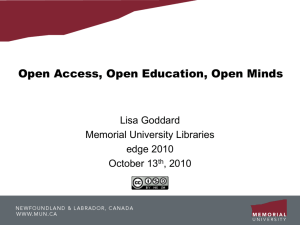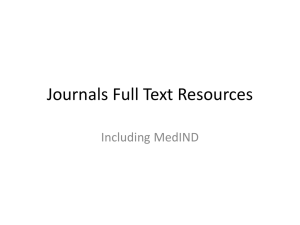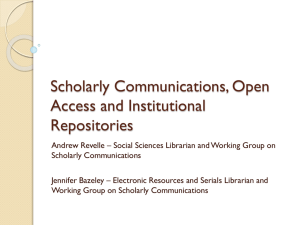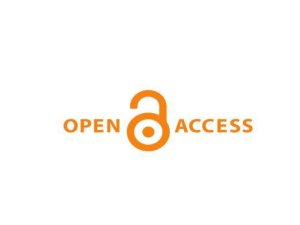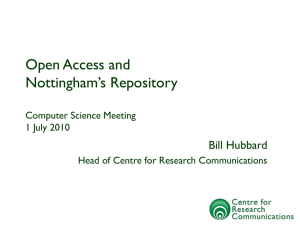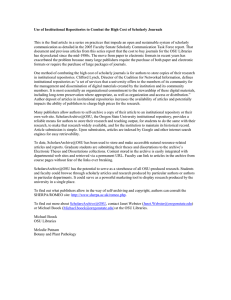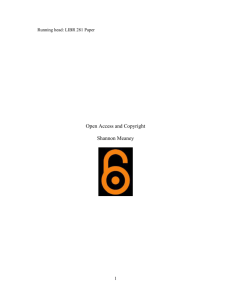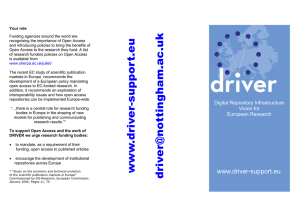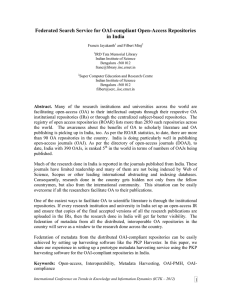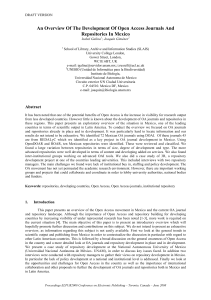University Library Committee Meeting Minutes 11/14/11 Members present: Ex-officio member present:
advertisement
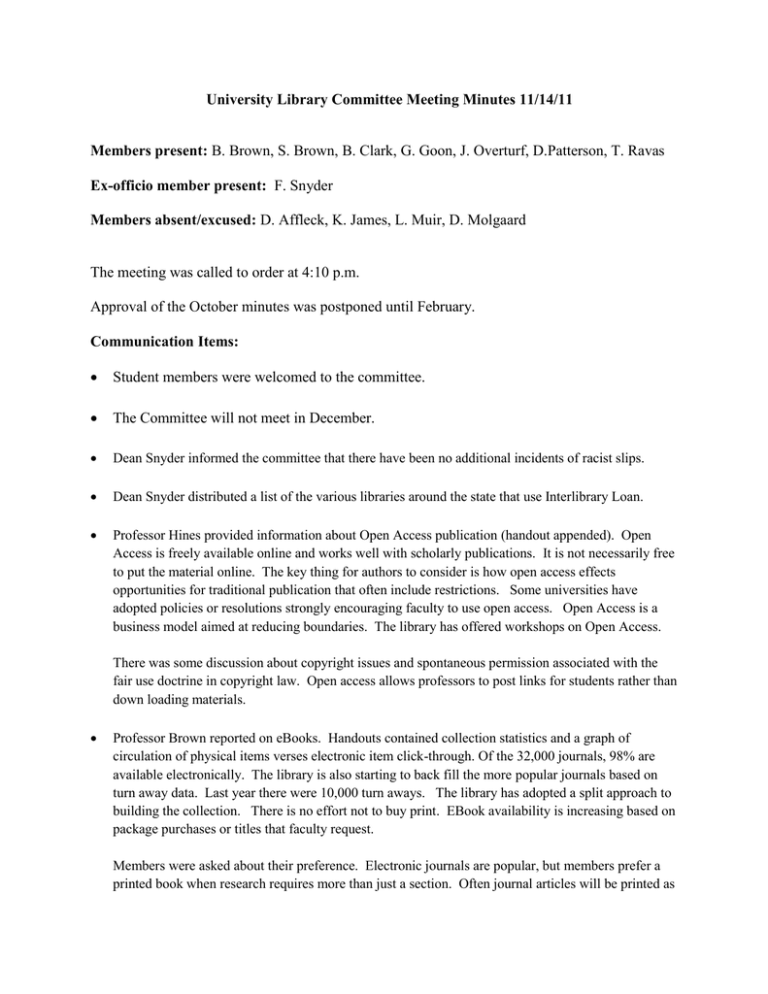
University Library Committee Meeting Minutes 11/14/11 Members present: B. Brown, S. Brown, B. Clark, G. Goon, J. Overturf, D.Patterson, T. Ravas Ex-officio member present: F. Snyder Members absent/excused: D. Affleck, K. James, L. Muir, D. Molgaard The meeting was called to order at 4:10 p.m. Approval of the October minutes was postponed until February. Communication Items: Student members were welcomed to the committee. The Committee will not meet in December. Dean Snyder informed the committee that there have been no additional incidents of racist slips. Dean Snyder distributed a list of the various libraries around the state that use Interlibrary Loan. Professor Hines provided information about Open Access publication (handout appended). Open Access is freely available online and works well with scholarly publications. It is not necessarily free to put the material online. The key thing for authors to consider is how open access effects opportunities for traditional publication that often include restrictions. Some universities have adopted policies or resolutions strongly encouraging faculty to use open access. Open Access is a business model aimed at reducing boundaries. The library has offered workshops on Open Access. There was some discussion about copyright issues and spontaneous permission associated with the fair use doctrine in copyright law. Open access allows professors to post links for students rather than down loading materials. Professor Brown reported on eBooks. Handouts contained collection statistics and a graph of circulation of physical items verses electronic item click-through. Of the 32,000 journals, 98% are available electronically. The library is also starting to back fill the more popular journals based on turn away data. Last year there were 10,000 turn aways. The library has adopted a split approach to building the collection. There is no effort not to buy print. EBook availability is increasing based on package purchases or titles that faculty request. Members were asked about their preference. Electronic journals are popular, but members prefer a printed book when research requires more than just a section. Often journal articles will be printed as well. There will be discussion about the variety of eBooks formats at a subsequent meeting. Members were provided with a Library organizational chart and given a tour of Bibliographic Management Services. This area of the library is where ordering and processing (labeling, cataloging, and digitizing) takes place. Members were shown the digitizing machine, donated collections and the receiving area. The digitizing machine is able to document 3-D objects. Often books will be ordered from Amazon with a Procard depending on the need. Amazon has overnight delivery. Shipping boxes are recycled. Some repairs and binding (high use journals) are done in the library. The committee would like to be informed about the policy to take a book out of circulation. The meeting was adjourned at 5:00 p.m. Open Access: Basic Information Prepared by Samantha Hines for the Faculty Library Committee, Nov. 2011 A Very Brief Introduction to Open Access by Peter Suber, Senior Researcher @ SPARC1 Open-access (OA) literature is digital, online, free of charge, and free of most copyright and licensing restrictions. What makes it possible is the internet and the consent of the author or copyright-holder. In most fields, scholarly journals do not pay authors, who can therefore consent to OA without losing revenue. In this respect scholars and scientists are very differently situated from most musicians and movie-makers, and controversies about OA to music and movies do not carry over to research literature. 1 This definition is provided by Dr. Suber for use under a Creative Commons Attribution 2.5 license. For more information visit http://creativecommons.org/licenses/by/2.5/ OA is entirely compatible with peer review, and all the major OA initiatives for scientific and scholarly literature insist on its importance. Just as authors of journal articles donate their labor, so do most journal editors and referees participating in peer review. OA literature is not free to produce, even if it is less expensive to produce than conventionally published literature. The question is not whether scholarly literature can be made costless, but whether there are better ways to pay the bills than by charging readers and creating access barriers. Business models for paying the bills depend on how OA is delivered. For a longer introduction, with live links for further reading, see my Open Access Overview, http://www.earlham.edu/~peters/fos/overview.htm. Open Access Venues There are several outlets for open access literature. Many journals now publish under an open access model, and several of these are peer-reviewed in the traditional manner. The best resource for finding these publishers is to visit the Directory of Open Access Journals at http://www.doaj.org/. The United States alone has 1342 journals listed through this directory in a wide variety of disciplines. Another key venue is that of an institutional repository. The Scholarly Publishing and Academic Resources Coalition (SPARC) describes institutional repositories: Online archives of universities, colleges, funding agencies, and other institutions — known as “repositories” — are key components of the emerging digital research infrastructure and can help ensure the widest possible sharing of your works. These repositories collect, preserve, and provide free, unrestricted online access to all types of institutional research outputs — seamlessly linking data, knowledge, and scholars. (http://www.arl.org/sparc/repositories/index.shtml) More information about institutional repositories generally can be found on the SPARC website referenced above. The Mansfield Library is in the process of creating an institutional repository; the key contact is Sam Meister, Digital Archivist, at sam.meister@umontana.edu. The Library’s Electronic Theses and Dissertations repository already follows an open access model and can be viewed at http://www.lib.umt.edu/etd. It’s important for authors considering open access models alongside traditional publishing (such as those depositing a preprint of an article in an institutional repository) to remember that traditional publishers often limit the rights of authors to distribute or redistribute published works, even if the author holds the copyright. For more information about what to look for in publishing agreements, please visit the Mansfield Library’s guide to Copyright for Authors at http://libguides.lib.umt.edu/copyrightforauthors. Open Access Policies A number of universities have adopted open access policies, usually at the request of faculty members. These polices can range from the support of an open access institutional repository for faculty and university publications, to requirements that faculty only publish in open access venues. Most recent as of this writing is Princeton University, which on October 31st announced that they had begun implementing an open access policy passed by their faculty senate in September of this year. Under their open-access policy, faculty members may publish their work on University sites, personal websites and other not-for-fee venues, but are not to publish articles in journals following a traditional publishing model. Early this month a newly-formed group of universities calling themselves the Coalition of Open Access Policy Institutions (or COAPI) will meet for the first time at the Berlin 9 Open Access Conference in Washington, D.C. These 22 universities have varying policies but share a commitment to open access publishing and the use of open access institutional repositories. A list of the organizations with links to their policies and repositories can be found at http://openbiomed.info/2011/08/coapi-cats/. A larger and more international list of institutions with open access policies can be found at http://roarmap.eprints.org/, which also links to their repositories, offers analysis of their policies, and labels their policies as institutional mandates, sub-institutional mandates, multi-institute mandates, funder mandates or thesis mandates. Some government agencies and other funders have begun adopting open access policies for funded research. The goal is to make the results of funded research openly available to the public. The most prominent example is the National Institute of Health, whose open access policy is available here: http://publicaccess.nih.gov/ Further Questions and Information The Mansfield Library is developing an Open Access guide page, which will be located at http://libguides.lib.umt.edu/OA. This page will serve as a clearinghouse for information for the University of Montana community on open access issues and initiatives. We also plan to provide more face-to-face information sessions for faculty and graduate students on the issue (we have provided several over the past two years). If you have questions, ideas or suggestions as we build our information resources regarding open access, please feel free to contact Samantha Hines at Samantha.hines@Umontana.edu or x7818.
